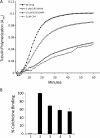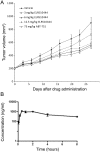ELR510444, a novel microtubule disruptor with multiple mechanisms of action
- PMID: 21148249
- PMCID: PMC3061540
- DOI: 10.1124/jpet.110.175331
ELR510444, a novel microtubule disruptor with multiple mechanisms of action
Abstract
Although several microtubule-targeting drugs are in clinical use, there remains a need to identify novel agents that can overcome the limitations of current therapies, including acquired and innate drug resistance and undesired side effects. In this study, we show that ELR510444 has potent microtubule-disrupting activity, causing a loss of cellular microtubules and the formation of aberrant mitotic spindles and leading to mitotic arrest and apoptosis of cancer cells. ELR510444 potently inhibited cell proliferation with an IC(50) value of 30.9 nM in MDA-MB-231 cells, inhibited the rate and extent of purified tubulin assembly, and displaced colchicine from tubulin, indicating that the drug directly interacts with tubulin at the colchicine-binding site. ELR510444 is not a substrate for the P-glycoprotein drug transporter and retains activity in βIII-tubulin-overexpressing cell lines, suggesting that it circumvents both clinically relevant mechanisms of drug resistance to this class of agents. Our data show a close correlation between the concentration of ELR510444 required for inhibition of cellular proliferation and that required to cause significant loss of cellular microtubule density, consistent with its activity as a microtubule depolymerizer. ELR510444 also shows potent antitumor activity in the MDA-MB-231 xenograft model with at least a 2-fold therapeutic window. Studies in tumor endothelial cells show that a low concentration of ELR510444 (30 nM) rapidly alters endothelial cell shape, similar to the effect of the vascular disrupting agent combretastatin A4. These results suggest that ELR510444 is a novel microtubule-disrupting agent with potential antivascular effects and in vivo antitumor efficacy.
Figures






References
-
- Baluk P, Hashizume H, McDonald DM. (2005) Cellular abnormalities of blood vessels as targets in cancer. Curr Opin Genet Dev 15:102–111 - PubMed
-
- Banerjee A, Luduena RF. (1992) Kinetics of colchicine binding to purified beta-tubulin isotypes from bovine brain. J Biol Chem 267:13335–13339 - PubMed
-
- Chen JG, Horwitz SB. (2002) Differential mitotic responses to microtubule-stabilizing and -destabilizing drugs. Cancer Res 62:1935–1938 - PubMed
-
- Chiou JF, Liang JA, Hsu WH, Wang JJ, Ho ST, Kao A. (2003) Comparing the relationship of Taxol-based chemotherapy response with P-glycoprotein and lung resistance-related protein expression in non-small cell lung cancer. Lung 181:267–273 - PubMed
Publication types
MeSH terms
Substances
Grants and funding
LinkOut - more resources
Full Text Sources
Miscellaneous

